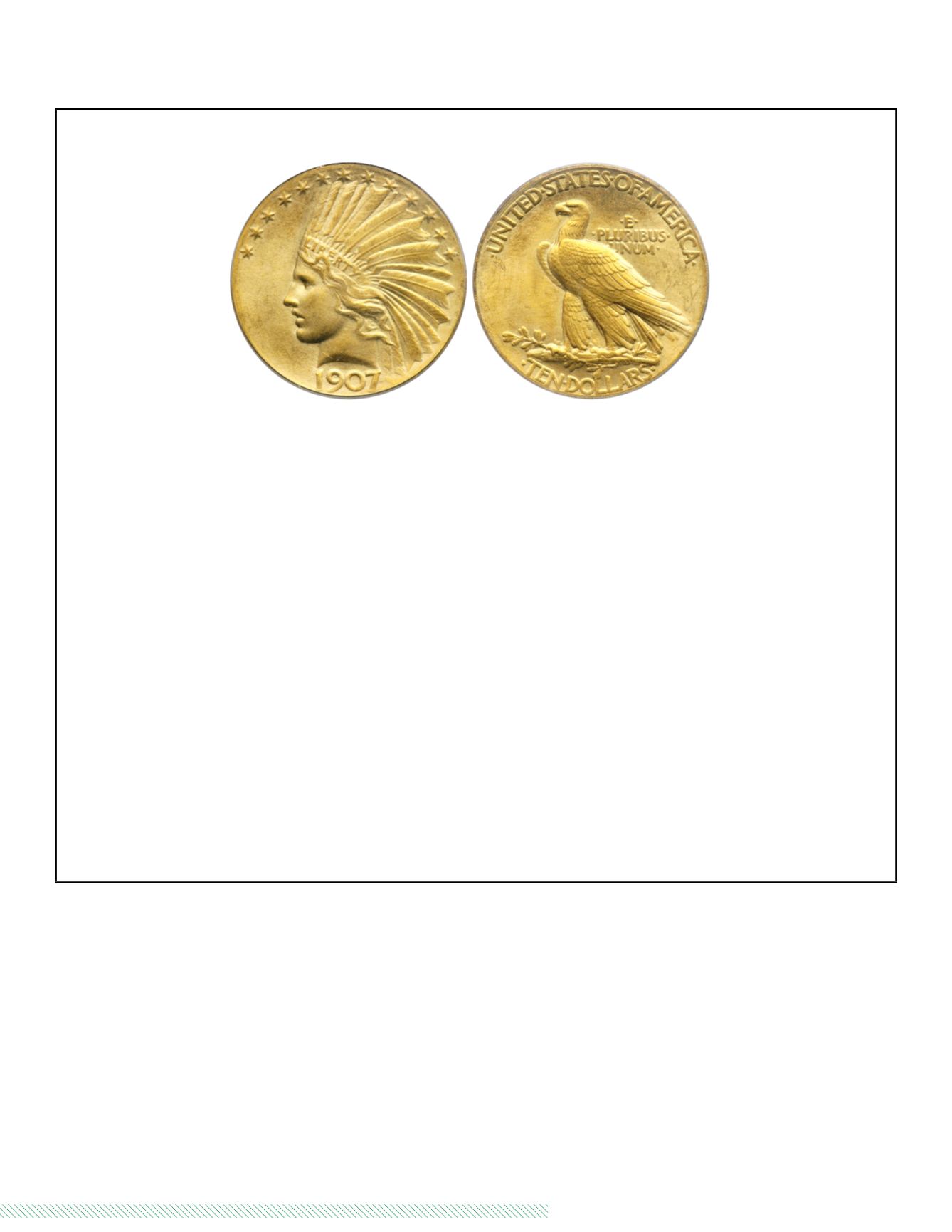
1
299
bid online at
(800) 978-COIN (2646)
|
Session Four - Tuesday, June 3, 2014 6:00 PM
$10 Ind i an
I
MPORTANT
1907 W
IRE
R
IM
I
NDIAN
E
AGLE
Enlargement
1944
1907. Wire rim, periods
.
PCGS graded MS-65
. A hint of golden toning. A very popular key date. Housed in an Old Green Holder. Only
500 struck. Numismatists consider 1907 to be a watershed year in American coinage innovation. Tossed aside as outdated were several mid-
dle-of-the-road coin designs that had outlived their purpose. President Theodore “Teddy” Roosevelt, spearheaded the revolution. Wielding his
authority, he forced the Mint to bring its coinage design up to twentieth century standards. This was an time when politicians and statesmen
were flexing the government's muscles, so to speak. The United States’ brand-new navy, christened the Great White Fleet, was steaming on
a world tour as sort of a chest-pounding exercise. What we were telling the other great powers was that America, too, was a power to be
reckoned with in the imperial age; America, too, could throw its iron muscle around; America showed that it had the wherewithal to defend its
territorial interests. Regardless of one's opinion of nationalism, Theodore Roosevelt exemplified it and was in the vanguard of this American
thinking. These elegant Ten Dollar Pieces by Augustus Saint-Gaudens were one of the more visible responses to this modernization program,
and should be cherished as others cherish artifacts from prior, historic openings.
The Wire Edge $10 is one of a mere 500 pieces made without intentions of circulation, technically making the Wire Edge ten a pattern (Judd-
1774). This issue was the closest the mint came to reproducing the ten-dollar design as conceived by Augustus Saint-Gaudens and Theodore
Roosevelt. The presently offered coin has subtly variegated coloration, pristine satin-like field and devices, and only the most trivial of marks,
none of them which are important. The die polishing swirls (common on all specimens) are a little more pronounced on the reverse fields than
the obverse, while overall the coin has a bright satiny sheen. A bold Gem coin.
Originally, Saint-Gaudens wanted President Roosevelt to authorize the use of a standing figure, but the President preferred a head on the gold
Eagle, feeling that the heroic effect of any standing figure, as chosen for the double eagle, would be lost in smaller diameter. The profile the
artist chose originated in a figure of Nike ('Victory'part of his Gen. Sherman Monument (1905), ultimately inspired by a Hellenistic Wingless
Victory on the temple of Zeus Soter. At Roosevelt's insistence, and for no other reason, Saint-Gaudens gave this head a nationalistic character
by the adding a feathered war bonnet, such as neither Liberty nor any Native American woman would ever have worn. That is how the mis-
leading sobriquet of "Indian head" arises, properly applicable only to Bela Lyon Pratt's 1908-29 half eagles and quarter eagles. (Possibly the
war bonnet also served to conceal any connection with the Sherman monument, to minimize protests in the South, puts forward the Breen
encyclopedia.)
Saint-Gaudens' standing-eagle device is splendid in its original form, reminiscent of late Egyptian and early Roman work at its best.
Pop 58;
26 finer, 4 in 65+, 16 in 66, 6 in 67.
(
PCGS # 8850
)
Estimated Value ........................................................................................................................................................... $60,000 - 65,000


